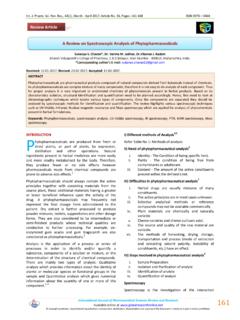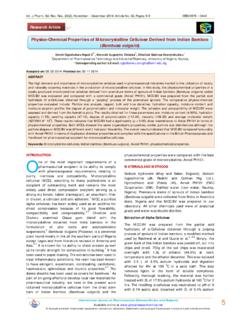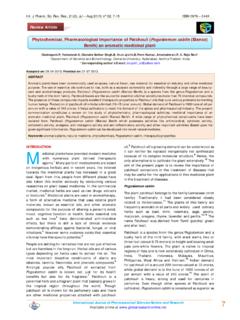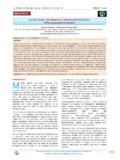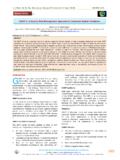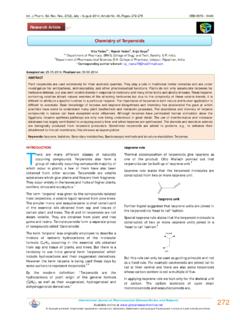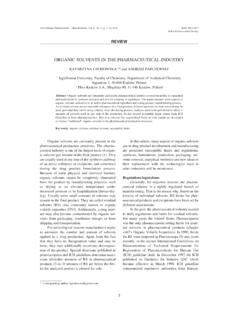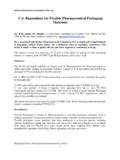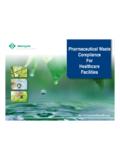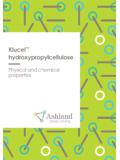Transcription of Starch as Pharmaceutical Excipient - Global …
1 Int. J. Pharm. Sci. Rev. Res., 41(2), November - December 2016; Article No. 14, Pages: 59-64 ISSN 0976 044X. Review Article Starch as Pharmaceutical Excipient 1,2 2 2 2*. Barmi Hartesi , Sriwidodo , Marline Abdassah , Anis Yohana Chaerunisaa 1. Program Studi Farmasi, STIKES Harapan Ibu Jambi, Jalan Tarmizi Kadi No 71, Kota Jambi, Indonesia. 2. Pharmaceutical Technology Departement, Faculty of Pharmacy, Universitas Padjadjaran, Jalan Raya Bandung- Sumedang , Jatinangor 45363, Sumedang Indonesia. *Corresponding author's E-mail: Accepted on: 12-09-2016; Finalized on: 30-11-2016. ABSTRACT. It is very well known that none of Pharmaceutical preparations either for internal or external use can be manufactured without excipients. Excipient is defined as any substance other than active drug or pro-drug that is included in the manufacturing process or is contained in finished Pharmaceutical dosage forms. Selecting best excipients, however, requiring a balance between time and cost efficiencies as well as anticipated product performance.
2 Starch is one of the traditional excipients used in the manufacture of tablets. Chemically, starches are polysaccharides, composed of a number of monosaccharides or sugar (glucose) molecules linked together with -d-(1-4) and/or -d-(1-6) linkages. Starch has been investigated as an Excipient in novel drug delivery systems for nasal, oral, periodontal, and other site-specific delivery systems. Depending on the application, specific starches are available for use as disintegrants, fillers or binders. As a result of its partial cold water solubility, Starch functions exceptionally well in tablet manufacture by wet granulation applications and performs dual functions of both a disintegrant and a binder. In capsule filling processes, Starch and Star Cap Co-Processed Starch Excipients function as effective binders. As a result of its partial cold water solubility, Starch functions exceptionally well in tablet manufacture by wet granulation applications and performs dual functions of both a disintegrant and a binder.
3 In capsule filling processes, Starch function as effective binders. Starch is also one of the most commonly used tablet disintegrants at concentrations of 3 15% w/w. However, unmodified Starch does not compress well and tends to increase tablet friability and capping if used in high concentrations. As a diluent, Starch is used to facilitate subsequent mixing or blending processes in manufacturing operations. Keywords: Starch , Binder, Disintegrants, Diluent. INTRODUCTION source of energy. Although Starch is widespread, abundantly available, cheap, degradable, pollution-free A ccording to the international Pharmaceutical Excipient council, Excipient is defined as Any substance other than active drug or pro-drug that is included in the manufacturing process or is contained in finished Pharmaceutical dosage forms . The US. and renewable, it has many short falls, , insoluble in cold water, easy to dehydration, low emulsifying power and unstable in acid, due to which commercial application is A survey of the literature shows that the usefulness of starches from various botanical sources as pharmacopoeia-National formulary (USPNF) categorizes Pharmaceutical excipients.
4 Starches are widely available excipients according to the functions they perform in the and have been very useful in tablet production due to formulations Binders, disintegrants etc1. Choosing their inertness, cheapness and utilization as fillers, the right excipients can make all the difference in the binders, disintegrants and glidants. 4. efficient production of robust tablets. Pharmaceutical formulators are seeking ways to improve the Chemically, starches are polysaccharides, composed of a manufacturing process and product quality through the number of monosaccharides or sugar (glucose) molecules use of functional excipients. Selecting the best excipients, linked together with -d-(1-4) and/or -d-(1-6) linkages. however, is a juggling act, requiring a balance between Starch consists of 2 main structural components, the time and cost efficiencies as well as anticipated product amylose, which is essentially a linear polymer in which performance.
5 Glucose residues are -d-(1-4) linked typically constituting 15 20% of Starch , and amylopectin, which is a larger Excipients are Pharmaceutical additives, the inactive branched molecule with -d-(1-4) and -d-(1-6) linkages ingredients used to make up a medication. They include and a major component of Starch . Amylose is linear or dyes, flavors, binders, emollients, fillers, lubricants, slightly branched with a degree of polymerization up to preservatives, and many more classifications. Common 6000, and has a molecular mass of 105 106 g/mol. The excipients used as fillers include corn Starch , lactose and chains can easily form single or double helices. Dibasic Calcium phosphate ,2. Amylopectin on the other hand, has a molecular mass of Starch is one of the most abundant natural carbohydrates 107 109 g/mol. It is highly branched and has an average stored in plants. It is found in many different plant organs degree of polymerization of 2 million, making it one of including seeds, fruits, tubers and roots, functioned as a the largest molecules in nature.
6 Chain lengths of 20 25. International Journal of Pharmaceutical Sciences Review and Research Available online at 59. Copyright protected. Unauthorised republication, reproduction, distribution, dissemination and copying of this document in whole or in part is strictly prohibited. Int. J. Pharm. Sci. Rev. Res., 41(2), November - December 2016; Article No. 14, Pages: 59-64 ISSN 0976 044X. glucose units between branch points are typical of products are usually differentiated based on the amylopectin. About 70% of the mass of Starch granule is manufacturing process to be used. Dry binders used for regarded as amorphous and about 30% as crystalline. The direct compaction must exhibit cohesive and adhesive amorphous regions contain the main amount of amylose, forces so that when compacted the particles and a considerable part of the amylopectin. The agglomerate. 5,6. crystalline region consists primarily of the amylopectin. Binders used for wet granulation are hydrophilic and The corn plant (Zea mays) is a high-capacity, factory for soluble in water and are usually dissolved in water to efficiently converting large amounts of radiant energy form a wet mass that is then granulated.
7 Binders function from the sun into stable chemical energy. This energy is as binder for both direct compression and wet stored as cellulose, oil and Starch in the corn plant and in granulation. As a dry binder, it compresses well, the corn kernel. The corn plant is also one of nature's predominately deforming plastically. It has been shown to greatest multipliers. Approximately four months after produce cohesive dry blends due to its granular planting, a single kernel of corn weighing about one one- morphology and superior adhesive characteristics. As a hundredth of an ounce will yield 800 kernels weighing result of its partial cold water solubility, Starch functions eight ounces. In comparison to this 800-fold seed exceptionally well in tablet manufactur by wet multiplication in corn, wheat will produce a 50-fold yield granulation applications and performs dual functions of per seed planted. Corn Starch is one of the traditional both a disintegrant and a binder.
8 In capsule filling excipients used in the manufacture of tablets. Depending processes, Starch and Star Cap Co-Processed Starch on the application, specific starches are available for use Excipients function as effective binders improving the as disintegrants, fillers or binders. tablet and capsule uniformity of the capsule fill as well as forming a stable 7,8 11. diluent; tablet and filler. capsule plug. Starch has been investigated as an Excipient in novel drug Binders are Pharmaceutical excipients that are commonly delivery systems for nasal, oral, periodontal, and other used in tablet formulation to impart cohesion on the site-specific delivery systems. Starch is also used in topical powder mix 12,13. The resultant cohesiveness ensures that preparations; for example, it is widely used in dusting the tablet remains intact after compression 14. Binders are powders for its absorbency, and is used as a protective used either in solutions or dry form depending on the covering in ointment formulations applied to the skin.
9 Other ingredients in the formulations and the method of Starch mucilage has also been applied to the skin as an preparation especially in wet granulation 13,15. The emollient, has formed the base of some enemas, and has quantity of binders used has a considerable influence on been used in the treatment of iodine the characteristics of the compressed tablets 8,16. Increasing the binder concentration invariably raises the Isolated Starch is typically a dry, soft, white powder. It is disintegration times. 17. insoluble in cold water, alcohol, ether and most organic solvents. Starch , if kept dry, is stable in storage for In tablet formulations, freshly prepared corn Starch paste indefinite periods. Though Starch granules are physically is used at a concentration of 5 25% w/w in tablet durable, they can be disrupted quite easily. If granules in granulations as a binder. Selection of the quantity water suspension are gradually heated, they begin to required in a given system is determined by optimization absorb water.
10 The granules hydrate, increase in size and studies, using parameters such as granule friability, tablet finally lose their structural integrity. This results in loss of friability, hardness, disintegration rate, and drug 9. characteristic birefringence and opacity, an increase in dissolution rate. viscosity, and the eventual formation of a paste or gel. Classification of Binders This process is referred to as Starch pasting or Solution binders are dissolved in a solvent (for example gelatinization. The temperature at the which water or alcohol can be used in wet granulation gelatinization of a Starch occurs the gelatinization processes). Examples Corn Strach. temperature is dependent upon such factors as Starch concentration, pH of the suspension, rate of heating, the Dry binders are added to the powder blend, either after a wet granulation step, or as part of a direct powder presence of certain salts, and the specific procedure being compression (DC) formula.
